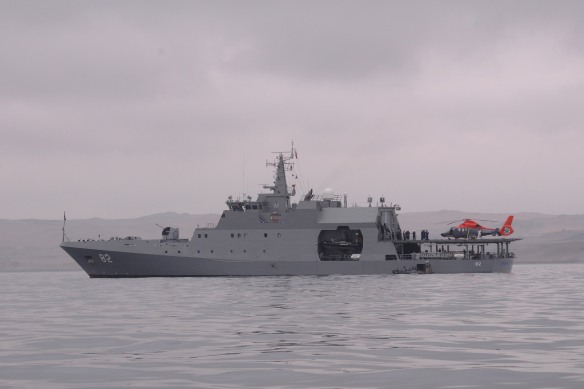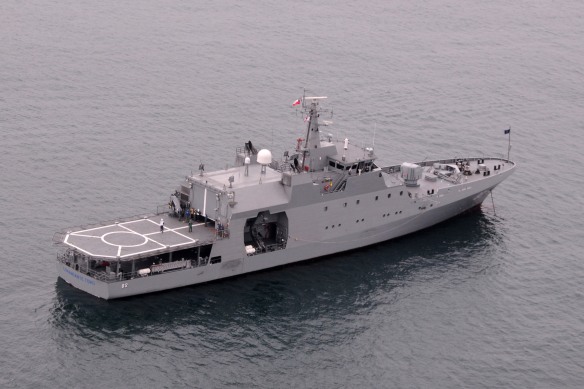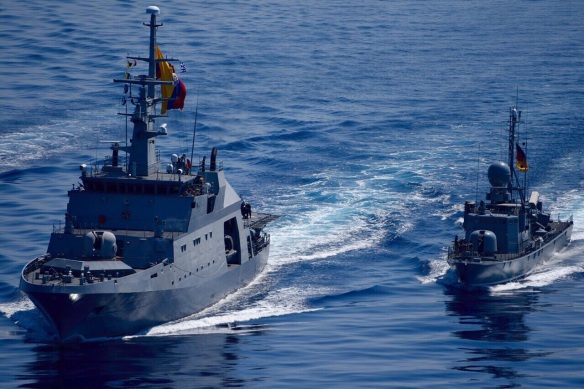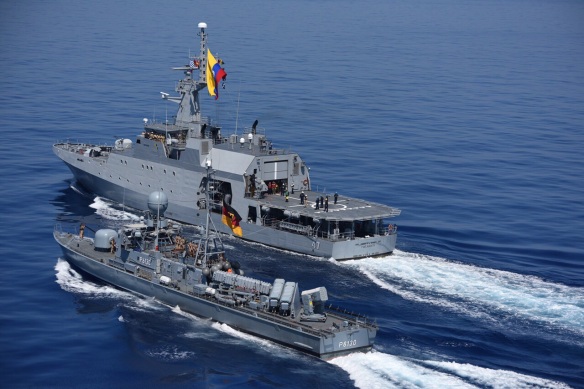
Photos: Chilean Navy photos of OPV Toro, 2012, note 40mm forward
We have a guest post today, Andres Tavolari, a 1st Lt in the Chilean Marine Corp Reserve talks about the recent christening of the third of a series of five ships that the US Coast Guard would consider Offshore Patrol Cutters. Not only have these ships supported SouthCom missions, Colombia and Argentina are also building ships of this class so cutters are likely to encounter and perhaps work with these or similar ships in their counter drug operations. Of the three countries Chile’s program is the most advance. Chuck
On last April 1st, was christened the third Fassmer-80 OPV for the Chilean navy. Named “Marinero Fuentealba” after a sailor who died trying to rescue the crew of a stranded ship on a storm in 1965, the new OPV will be delivered to the Navy in August 2014. This is the third ship of a class of five for the Chilean navy, which are built in the ASMAR shipyard, Talcahuano, Chile, a German design selected among several bidders (Fincantieri, Vosper Thornycraft, Kvaerner Masa Marine, Damen and Fassmer). The detailed engineering was done by ASMAR which did 50,000 hours of modeling on the ships’ systems and components. The ships are classified as LRS +100 A1 LMC UMS.
The original design was modified in several aspects, most importantly, the addition of a hangar for a medium size helicopter. With an overall length of 80,60 meters (264′), a waterline length of 74,40 (244′) and a moulded beam of 13,00 meters (42.6′), the Chilean Fassmer 80 OPV have a full load displacement of 1728 tons. With such a displacement, at 12 knots, their range is 8.000 nautical miles with accommodations for 60 persons including 20 passengers and the helicopter crew. The endurance is 30 days, carrying 298 m3 of fuel oil, 48 m3 of fresh water and 20 m3 of helicopter fuel. Two 12V26 Wärtsilä engines, delivering 4.080 KW (5,471 SHP each) @ 1.000 rpm, work on two 4 blades controllable pitch propelers. At 80% MCR the speed is 20 knots. The first 2 ships are armed with a 40 mm gun taken second hand from German Type 148 missile boats, and with up to six .50 machine gun, although normally four are embarked. The third ship, the “Fuentealba” will be armed with a 76 mm Oto Melara gun also from a Type 148 missile boat. Some sources indicate its secondary armament will be up to 6 x 20 mm guns (probably old Oerlikon 20mm/70). This third ship has an ice strengthened hull and a different communications set, details have not been released yet. With these modifications “Fuentealba” will cost 43% more than the first two ships of the class, whose cost was less than $50M US each. The flight deck and hangar are optimized for medium helicopters. Normally an AS-365 N2 Dauphin helicopter, similar to the MH-65, will be embarked. Typically it will be used for MIO and rescue operations.
There are two single points davits for two locally built 7,40 meters RIBs which can be launched and recovered while sailing at up to 12 knots. Under the flight deck is a working space with enough space for up to three 20 foot container sized units. There are four hatches in the flight deck permitting an easy access to the work deck. It is served by a Palfinger Marine PK 60000M crane installed on the flight deck. On the work deck and stern are the necessary fittings for towing other ships, towing being one of the main mission of this class of ships in Chilean service. Notably the second ship in the class (OPV 82 “Toro”) has, on the stern, 2 racks for depth charges!! Although an old weapon, several Chilean navy ships have been equipped with depth charges, as useful weapons for warning shots against submarines.
The Chilean Fassmer 80 OPVs have a Sperry Marine integrated Bridge System, an integrated communication system and an unmanned machinery space, remotely controlled. They are also equipped with the Mobile Maritime Command and Control System “SMC MM” and the ARIES fire control system for the 40 mm gun. Both systems are developed locally by SISDEF and DESA CHILE. It is most probable that the “Fuentealba” will be equipped with the SAETA fire control system, developed by DESA CHILE for the Chilean SA’AR missile boats armed with 76 mm guns.
The Chilean OPVs are operated by the Dirección General del Territorio Marítimo (DIRECTEMAR), a special branch within the Chilean Navy. The missions carried out by this ships are: coast guard, fishery protection, search and rescue, contamination control, training and support of isolated communities. Nevertheless, the first two ships have also deployed to international exercises and operations, such as UNITAS, PANAMAX and MARTILLO, the last one in combination with forces of the US Southern Command for fighting drugs smuggling in the Caribbean. The Colombian navy has received 2 slightly modified ships build locally by COTECMAR and has contracted a third ship, planning to build as many as 6, for operating 3 in the Pacific and 3 in the Caribbean (Argentina is also planning at least four-Chuck). Main modifications are a different mast, a different 40 mm gun, a telescopic hangar for a Bell 412 helicopter and a stern ramp. The stern ramp was considered less important for the Chilean Navy, which opted for improved towing capacity of towing ships and additional space for supporting isolated communities rather than the improved ability to deploy a boat quickly when chasing “go-fast” boats, since this is not a threat in Chilean waters. The OPV “Fuentealba” will be deployed to the Third Naval Zone, with homeport in Punta Arenas, on the Magellan Strait.
Thanks to Andres for his contribution. I noted this in the German Navy blog “Marine Forum” Daily News, 8 April, “CHILE – PERU Probably related to their ongoing dispute over Pacific Ocean sea areas, both the Chilean and Peruvian navy have (temporarily?) removed hull numbers and names from nearly all naval vessels, rendering identification difficult.” Hopefully this will be resolved amicably. Chuck
Addendum:
Photos provided Andres Tovalari. Colombian Navy OPV “7 de Agosto” sailing along a German Navy missile boat. Ship is currently part of Operation Atalanta countering piracy in the Indian Ocean.
As noted here,
“With 85 sailors on board, 7 de Agosto is armed with a 40 mm Oto Melara 40L70 twin gun, a 20 mm Oerlikon GAM-BO1 gun, and two Thor T-12 Remote Controlled Weapons Stations (RCWS). The T-12 RCWS includes a .50-calibre M2HB machine gun linked to a Controp SHAPO maritime day/night observation system.”
It is less obvious, but she also has a stern boat ramp as well.





Super ships. I have mentioned them over at Think Defence on several occasions. I wish we were getting these and not the BAE design for our new “make work” OPVs that will plug the gap between the end of CVF production and the start of the T26 builds.
Thinkdefence picked this up and added some additional information including a video from Chilean builder. http://www.thinkdefence.co.uk/2014/04/opv-design-chucks-house/
From the German Navy Blog Marine Forum (http://marineforum.info/Daily_News/daily_news.html), 6 Nov, “CHILE, Third PILOTO PARDO class offshore patrol vessel, MARINERO FUENTEALBA, commissioned during ceremony at Asmar shipyard in Talcahuano … will be based in Punta Arenas (3rd Naval Zone)” This is the vessel that was ice strengthened and better armed than the first two on the class.
Interestingly, while Colombia obviously has a drug problem, they also fear their neighbors and have been making noise about joining NATO, so we have this from the German Navy blog Marine Forum, ” 08 August, Anti-Piracy Forces: Colombian Navy offshore patrol vessel 7 DE AGOSTO (one of the class talked about above–Chuck) arrives in the Gulf of Aden to join EU NavFor in operation „Atalanta“ … (not the NATO task force for some reason?–Chuck) Spanish Navy team embarked to coordinate operations.”
Actually these are almost ideal ships for counter piracy, but that problem, off the Horne of Africa, is largely resolved. They might have done more for good will by volunteering to help with Migrant problem in the Med.
Another version of the report with photo here: http://www.janes.com/article/52651/colombian-navy-deploys-opv-to-support-atalanta
Cdr. Salamander has a short post on these ships that includes this video from a shipyard in Chile that builds them. http://cdrsalamander.blogspot.com/2015/08/whos-down-for-opv.html#disqus_thread
I’ve added an addendum to the original post with some pictures from the original author of one of the Colombian OPVs of this class, along with info on its armament (see at the bottom of the original post above).
Pingback: Thanks for a Successful 2015 | Chuck Hill's CG Blog
Pingback: Chilean Icebreaker/Supply Vessel, plus Other News From Chile | Chuck Hill's CG Blog
Reportedly Fassmer who designed these is in the running to provide the design for 12 projected OPVs for Australia. Also short listed are Damen and Lürssen. Construction should start a bout the same time as the OPC, in 2018. http://www.marinelink.com/news/shipbuilding-accelerates408275.aspx
Expected cost is about $200M (US) each.
Pingback: “Latin American Navies Combat Illegal Fishing”–CIMSEC | Chuck Hill's CG Blog
Pingback: Chile Christens Its Forth 80 meter OPV | Chuck Hill's CG Blog
Following recieved from Andres, author of this post,
I have also added a new photo to the end of the post.
From German Navy blog “Marine Forum” 1 Dec.:
CHILE: Work on FASSMER OPV 80 class „Cabo Odger“ progressing at ASMAR shipyard … delivery expected around April, 2017
COLOMBIA: COTECMAR launches 3rd FASSMER OPV-80 class offshore patrol vessel „Santander“ (48)
https://www.fassmer.de/press-releases-2016/fassmer-erhaelt-auftrag-ueber-drei-neue-einsatzschiffe-fuer-die-bundespolizei/
New German Police Coast Guard vessel based on OPV 80 FASSMER SHIPBUILDING
Two news items on this class from the German Navy blog, Marine Forum. http://marineforum.info/Daily_News/daily_news.html
11 January
CHILE
The Chilean Navy and state-owned ASMAR shipyard are studying the possibility of building corvettes to replace three Israeli-built SA‘AR 4 fast missile craft that will reach the end of their service lives within the next decade … consider developing OPV-80 design (German Fassmer) into a 2,200-2,600 ton missile corvette
COLOMBIA
State-owned COTECMAR shipyard has begun designing an offshore patrol vessel (OPV) larger than current 1,800-ton 20 DE JULIO class vessels … to meet a Colombian Navy requirement for patrol ships with greater range for extended open-ocean patrols in the Pacific.
Pingback: Malaysia Builds 6 WPC w/sUAS, 3 Cutter X, and Gets 2 JCG cutters | Chuck Hill's CG Blog
From the German Navy blog Marine Forum, 30 March 2017, “COLUMBIA, COTECMAR is building a 4th FASSMER OPV 80 patrol ship … named „Victoria“”
Pingback: Lighthouses in Chile | Chuck Hill's CG Blog
Appears Australia will be building twelve of these. http://www.navyrecognition.com/index.php/news/defence-news/2017/may-2017-navy-naval-forces-defense-industry-technology-maritime-security-global-news/5189-austal-to-open-new-shipbuilding-design-project-management-office-in-adelaide.html
Pingback: LATIN AMERICAN NAVIES AND ANTARCTICA–CIMSEC | Chuck Hill's CG Blog
The author sent me a bit of an update on what Chile is doing.
“I want to tell you that one year after being christened, the OPV-84 Cabo Odger was delivered to the Chilean Navy. As announced in the web page of the Defense Ministry http://www.defensa.cl/noticias/cabo-odger-construido-en-asmar-presencia-fiscalizacion-y-vigilancia-para-la-zona-norte-del-pais/ and the Chilean Navy web page https://www.armada.cl/armada/noticias-navales/armada-cuenta-con-nuevo-buque-para-reforzar-los-patrullajes-maritimos-en/2017-08-10/151022.html, Cabo Odder is the 4th vessel of a 6 ship class, known as “Danubio IV”. (Danubio I, II and III was the construction of 16 Fairey Brooke Marine “Protector” patrol crafts).
Cabo Odger’s full load displacement is 1771,6 ton, exceeding OPV-81 Piloto Pardo and OPV-82 Comandante Toro, whose full load displacement is 1728 ton.
Like the third ship in class (OPV-83 Fuentealba), Cabo Odger is armed with an 76/62 gun, has an ice strengthened hull and costed 70 million dollar. But Cabo Odger has a different communication suite, which was not specified. It just was said that the new communication suite was different and more secure.
Cabo Odger’s missions are patrol, surveillance, jurisdictional waters maritime control, maritime search and rescue, pollution control, maritime signaling maintenance support, isolated locations logistic support, maritime police, “command and control of a defensive task force” (honestly, I don’t know what that means) and auxiliar transport.
Although her ice strengthened hull, she will be based in Iquique.
The OPV Odger is equipped with a Terma naval radar, as can be seen in this video: http://www.tvu.cl/prensa/tvu-noticias/2017/08/10/bachelet-nuevamente-visita-talcahuano-sin-referirse-al-tercer-dique-de-asmar.html (Minute 2:32). It is a significant departure of her sister ships which are equipped with up to three Sperry radars.
Thank you, Andres, like the fact the gun is located a deck above the Foc’sle. That should protect it somewhat from heavy seas. That is different from the previous ships I see.
Actually, the location of the gun one deck above the Foc’sle is a common feature of OPV-83 “Marinero Fuentealba” and OPV-84 “Cabo Odger”
I guess this solution was found not just for weather protection, but also as a way for avoiding the deck penetration of the ammunition carrousel and so avoiding to many changes to the original design.
Thanks, I had not noticed that.
Info on the radar here. https://www.terma.com/surveillance-mission-systems/radar-systems/naval-radar-surveillance/
Radar aside, there are other differences between OPV-83 “Marinero Fuentealba” and OPV-84 “Cabo Odger”. Notably, life rafts on the working deck (under the flight deck) and on the RIBs caves, were move to a new position above the hangar, freeing room on the sides of the ship.
On this picture of OPV-81 “Piloto Pardo” you can see three white life rafts: one on the working deck and two on the RIB cave. And none on the hangar roof.
On this picture of OPV-84 “Cabo Odger” you can’t see any life rafts on the RIB cave. (The people on the picture are relatives to “Cabo (corporal) Odger” who died on August 15, 1965, in the same accident as “Marinero (seaman) Fuentealba”. Both of them lost their lives rescuing other shipmates).
On this other picture of OPV-84 “Cabo Odger” you can’t see any life rafts on the working deck (under the flight deck).
Finally, on this picture of OPV-84 “Cabo Odger” you can see several gray life rafts on the hangar roof.
I wonder why such spaces on the side of the working deck and RIBs caves can be so important. The ship is getting additional weight very high – actually on the hangar roof – apparently just for winning some room on her sides. And in the three previous ships it seems that this room wasn’t relevant!
In reference to the third Colombian OPV. http://navaltoday.com/2016/12/02/colombian-navy-launches-third-offshore-patrol-vessel-arc-santander/
According to the Spanish-language website InfoDefensa, the vessel features several improvements over its two predecessors, ARC 20 de Julio and ARC 7 de Agosto. It has an upgraded armament with a 76 mm OTO Melara gun and a 25 mm M242 Bushmaster auto-cannon.
C4iSR: Maritime
Chile to upgrade Piloto Pardo class bridge command systems
Jose Higuera – IHS Jane’s Navy International
10 October 2017
The Chilean Navy has awarded a contract worth USD60,000 to local firm BZ Naval Engineering for the upgrade of the Northrop Grumman Sperry Marine’s VisionMaster FT integrated bridge command system fitted on board its four Piloto Pardo patrol ships.
The upgrade includes the replacement and integration of new CPUs, Windows 10, the addition of three TCI scan converters for improved screen presentation of images generated by sensors in the TotalWatch consoles, and a general software upgrade.
Want to read more? For analysis on this article and access to all our insight content, please enquire about our subscription options ihs.com/contact
Argentina never went through with this program. Apparently they are buying four L’Adroit class Offshore Patrol Vessels. http://www.dmitryshulgin.com/2018/04/06/offshore-patrol-vessels/
The author sent a couple of photos. This is in connection with a maritime commemoration that involves a 157 day circumnavigation of South America. Spanish language site with the projected schedule of port visits here. http://www.velaslatinoamerica2018.cl/index.html

Here is a detail of all the characteristics of the vessel
http://defence.nridigital.com/global_defence_technology_mar18/fassmer
Pingback: “Naval Group: Four OPVs for Argentina” –Marine Link | Chuck Hill's CG Blog
The German ships of this class are to receive 57mm guns. https://navaltoday.com/2019/09/04/german-offshore-patrol-vessels-getting-baes-57mm-naval-guns/
Third ship of this type has been delivered to the German Federal Police, complete with 57mm gun. http://www.navyrecognition.com/index.php/news/defence-news/2019/november/7714-coast-guards-of-german-federal-police-take-delivery-of-its-third-potsdam-class-offshore-patrol-vessel-bp-83.html
Fourth ship of the OPV86BP variant for Germany was ordered from Fassmer earlier this year, will be delivered mid-2023.
Will be identical to the other three German ships, including armament (57mm gun forward and two .50cal MG) and specific work deck/aviation deck configuration where it differs from standard OPV80 (i.e. 6m lengthened to allow second row for total of five TEU container space on work deck, low-height VTOL UAV garage hangar + crane installed in nominal hangar space).
Fourth German ship was commissioned last month – this is also the first one where the armament was already mounted during commissioning, the previous three vessels all had theirs installed only afterwards.
The new ship is currently escorting a Russian surface taskgroup around Udaloy class destroyer Severomorsk through German waters.
@katoult, thanks, great photo. Good to here how they are being used too.
Pingback: Offshore Patrol Cutter Program Alternatives | Chuck Hill's CG Blog
Pingback: New OPV, “Malaysia evaluates options for second batch of Littoral Mission Ships” –Janes | Chuck Hill's CG Blog
Pingback: UNITAS LXI Concludes | Chuck Hill's CG Blog
Pingback: Doing Unreps for Drug Enforcement–Stopping by Chile’s for a Drink | Chuck Hill's CG Blog
Report of one of this class’s participation in UNITAS exercise. https://seawaves.com/?p=16230
Pingback: “VESSEL REVIEW | FELIX SAND – FAST COASTAL RESPONSE BOAT FOR GERMAN SEA RESCUE SERVICE” –Baird Maritime | Chuck Hill's CG Blog
Pingback: NSC#9, USCGC Stone, Completes First Patrol Since Commissioning, Spends Time with Colombian Friend | Chuck Hill's CG Blog
Pingback: “Colombia inks deal that could see Damen build five Sigma frigates” –Defense News | Chuck Hill's CG Blog
Report on deployment of a Chilean OPV of this class to Antarctica.
https://seawaves.com/2023/04/03/marinero-fuentealba-patrols-magallanes-and-chilean-antarctic-region/
Singapore is buying four OPV80 from Fassmer, apparently based on the German BP86 version.
https://www.navalnews.com/naval-news/2023/11/singapore-orders-four-fassmer-offshore-patrol-vessels/
Pingback: “Singapore orders four offshore patrol vessels from Fassmer” –Naval Today | Chuck Hill's CG Blog